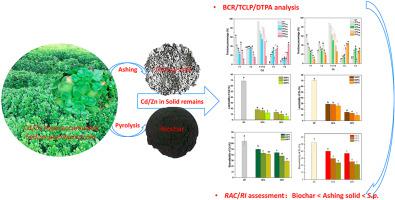Environmental Pollution ( IF 7.6 ) Pub Date : 2020-11-21 , DOI: 10.1016/j.envpol.2020.116039 Jin Zhang , Shuai Wu , Jialin Xu , Peng Liang , Minyan Wang , Ravi Naidu , Yanju Liu , Yu Bon Man , Ming Hung Wong , Shengchun Wu

|
Phytoremediation of metal(loid)s contaminated sites is widely used, while there is scarce of investigation on the metal-enriched biomass waste safely disposal which resulted in risks of causing secondary pollution to the soil and water bodies and even to human health. Thus, this study compared the effects of ashing and pyrolysis treatments on cadmium (Cd) and zinc (Zn) hyperaccumulation plant Sedum plumbizincicola. Chemical speciation, the Toxicity Characteristic Leaching Procedure (TCLP), and diethylenetriamine pentaacetic acid (DTPA) extraction were employed to characterize the bioavailability and leachability of Cd and Zn in the solid residues after pyrolysis and ashing. The risk assessment code (RAC) and potential ecological risk index (RI) were subsequently used to evaluate the risk of the solid residues to the environment. The results showed that both ashing and pyrolysis treatments could transform the bioavailable Cd and Zn in S. plumbizincicola into a more stable form, and the higher the temperature the greater the stablility. Pyrolysis converted a maximum of 80.0% of Cd and 70.3% of Zn in S. plumbizincicola to the oxidisable and residual fractions, compared with ashing which achieved only a ∼42% reduction. The pyrolysis process minimised the risk level of Cd and Zn to the environment based on the RAC and RI assessments. The results of the TCLP test, and DTPA extraction confirmed that the leaching rate and the bioavailable portion of Cd and Zn in the biochars produced by pyrolysis were invariably significantly (p < 0.05) lower than the solid residues produced by ashing, and reached the lowest at 650 oC. In other words, pyrolysis was better than ashing for thermal treatment of the metal-enriched hyperaccumulator plant, in view of minimising the bioavailability and leachability of Cd and Zn from the solid residues to the environment. This study provides fundamental data on the choice of treatments for the disposal of metal-enriched plant biomass.
中文翻译:

镉/锌超富集植物灰化和热解处理的比较:对固体残留物中生物利用度和金属形态的影响以及风险评估
植物(金属)污染位点的修复已被广泛使用,但对安全处理富含金属的生物质废物的研究却很少,这会导致对土壤和水体乃至人类健康造成二次污染的风险。因此,本研究比较了灰化和热解处理对镉(Cd)和锌(Zn)超富集植物景天景天(Sedum plumbizincicola)的影响。采用化学形态,毒性特征浸出程序(TCLP)和二亚乙基三胺五乙酸(DTPA)萃取来表征热解和灰化后固体残留物中Cd和Zn的生物利用度和浸出度。风险评估代码(RAC)和潜在生态风险指数(RI))随后用于评估固体残留物对环境的风险。结果表明,灰化和热解处理均可以将李氏链球菌的生物利用态镉和锌转化为更稳定的形式,温度越高,稳定性越好。热解一个最大的镉的80.0%,在锌的70.3%转化S. plumbizincicola到可氧化和残余馏分,其仅实现减少〜42%灰化进行比较。热解过程基于RAC和RI将Cd和Zn对环境的风险降至最低评估。TCLP测试和DTPA萃取的结果证实,热解产生的生物炭中的Cd和Zn的浸出率以及生物利用度始终比灰化产生的固体残留物低(p <0.05),并且达到最低在650 Ô C.换言之,热解比灰化的金属-富集的超积累植物的热处理,鉴于从固体残余物于环境减少Cd和Zn的生物利用度和可浸出性的更好。这项研究提供了有关处理富含金属的植物生物质的处理方法选择的基础数据。











































 京公网安备 11010802027423号
京公网安备 11010802027423号